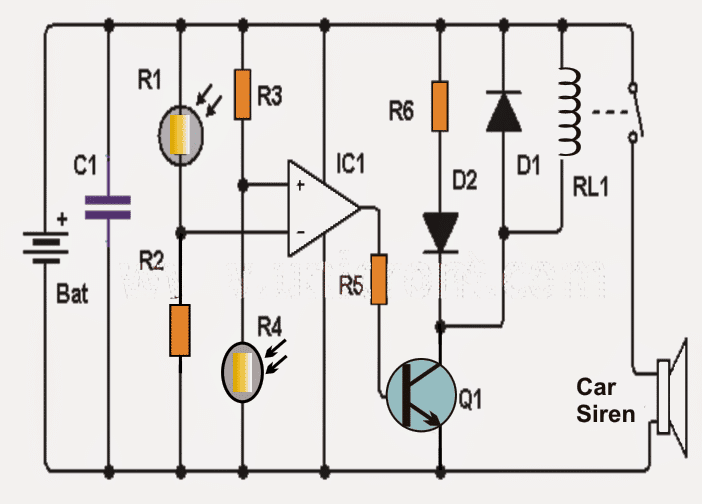Utilizing two LDRs, the mentioned shadow detector circuit efficiently detects variations in light intensity and sounds a loud warning siren.
The method of detection might not be as precise in circuits that just employ one LDR (photoresist) as it is with the two LDRs covered here.The following is a study of the shadow detector circuit's operational details:
The active operational amplifier, that acts as a comparator, and the two LDRs are the circuit's essential components.
How a Circuit Works
As can be seen from the diagram, the opamp's inputs are meticulously balanced by means of resistors and alternatively placed LDRs across the matching supply rails.
Presets might be used in lieu of the two resistors to provide an intricate modification alternative, guarantee ideal balance, and provide exact zero logic at the opamp's output.
A low logic level is produced at the IC's output when there is normal illumination, meaning when there is no shadow or shade and the two LDRs are able to catch an equal quantity of light through the opamp's sensing input.
The logic at the IC's output switches to a non-inverting logic whenever one of the LDRs (for example, R1) encounters a shadow with a smaller amount light compared to the other (R4), which lowers the voltage at the opamp's inverting input.
Transistor Q1 is activated by the aforementioned event, and the LED and relay are subsequently activated. Whenever the relay turns on a siren, the LED enables the acquisition of an optical prior warning.
To shield the transistor Q1 from the relay backward EMFs, it might be preferable to connect a semiconductor diode (D1) alongside with the relay, as indicated in the diagram.
Circuit Diagram

Notes: - The circuit is supplied by a 9 volt lead acid battery or any equivalent SMF battery. - In order to get most effective responsiveness and to prevent improper switching, the LDRs must be positioned around 3 cm apart.
Parts list for the proposed shadow detector circuit
| Quantity | Component Description | Designation |
|---|---|---|
| 1 | Operational amplifier: LM741 | IC1 |
| 2 | LDRs (photoresistor / LDR) | R1, R2 |
| 1 | NPN transistor 2N2222 or similar | Q1 |
| 1 | 1N4007 diode | D1 |
| 1 | Red LED diode | D2 |
| 1 | 9 volt relay | RL1 |
| 2 | 10K resistors | R3, R4 |
| 1 | 1K resistor | R5 |
| 1 | 470 ohm resistor | R6 |
| 1 | 100 nF capacitor | C1 |
Leave a Reply